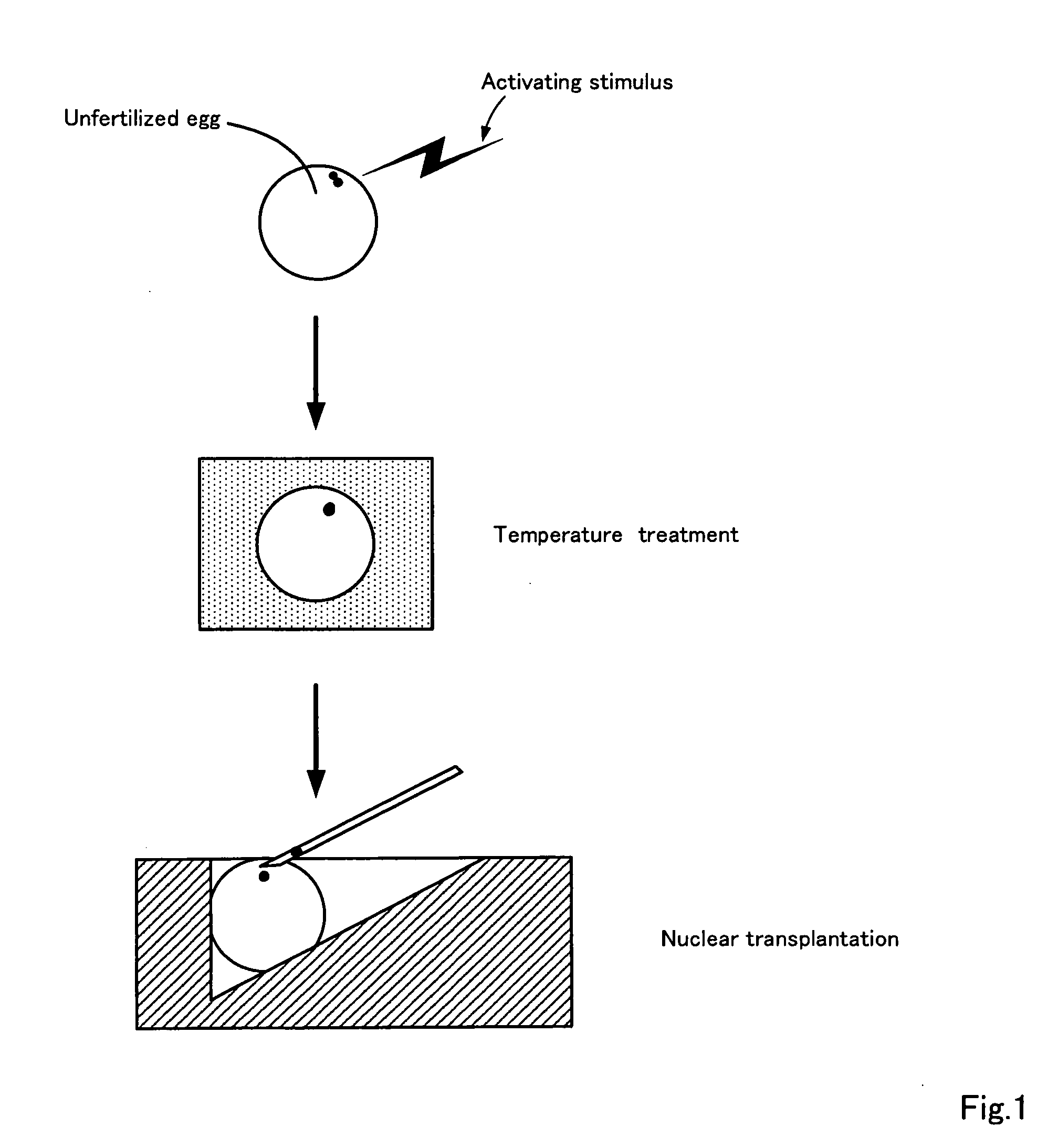Method for Preparing Fish Embryo
a technology of fish embryos and fish embryos, which is applied in the field of preparation of fish embryos, can solve the problems of not always being successful in obtaining fertile individuals by such a technology, and no technology has been established for stably constricting fish embryos, etc., and achieves the effect of efficient preparation of embryos
- Summary
- Abstract
- Description
- Claims
- Application Information
AI Technical Summary
Benefits of technology
Problems solved by technology
Method used
Image
Examples
example 1
[0063]The following examples illustrate the invention more specifically. The following examples are, however, by no means limitative of the scope of the invention. In this example, nuclear transplantation was carried out using embryonic cells of medaka (Oryzias latipes) and cultured cells derived from somatic cells thereof. In Experiments 1 and 2, nuclear transplantation was carried out using orange-red medaka obtained by gene transfer using the β-actin-cassette-EGFP gene as the donor and orange-red medaka (hereinafter referred to as “OR”) of an outbred strain as the recipient. The individuals obtained by nuclear transplantation were evaluated in sex, chromosomal ploidy, and GFP fluorescence and GFP gene detection and further subjected to test mating with the recipient OR. The F1 generation obtained by the mating test was observed from the growth viewpoint and evaluated with GFP fluorescence and GFP gene detection.
[0064]The donor β-actin-cassette-EGFP strai...
example 2
Investigations Concerning Conditions for Retention of the Second Polar Body Release by High Temperature Treatment
[0089]Female fishes that have been laying eggs everyday were transferred to an isolation tank on the day before experiment. On the day of experiment, they were dissected within 1-2 hours from the start of the light period and mature unfertilized eggs were recovered from ovaries. On the other hand, males were dissected, testes were excised and the tissues were squashed in BSS to give a sperm suspension. Unfertilized eggs were placed in 50 μl of BSS in an Eppendorf tube and a portion of the sperm suspension was added thereto for insemination. The tube was maintained at 25° C. for a predetermined period and then transferred to a water bath at 37° C. or 41° C. and maintained at either of the predetermined temperatures for a predetermined period. After this treatment, the eggs were transferred into BSS in a plastic culture dish and allowed to develop in an incubator at 26° C. ...
example 3
Investigations Concerning Conditions for Retention of the Second Polar Body Release by Low Temperature Treatment
[0092]Female fishes that have been laying eggs everyday were transferred to an isolation tank on the day before experiment. On the day of experiment, they were dissected within 1-2 hours from the start of the light period and mature unfertilized eggs (unfertilized eggs) were recovered from ovaries. On the other hand, males were dissected, testes were excised and the tissues were squashed in BSS to give a sperm suspension. Unfertilized eggs were placed in 50 μl of BSS in an Eppendorf tube and a portion of the sperm suspension was added thereto for insemination. The tube was maintained at 25° C. for a predetermined period and then immediately transferred onto ice and maintained at 0° C. for a predetermined period. After this treatment, the eggs were transferred into BSS in a plastic culture dish and allowed to develop in an incubator at 26° C. for 5-7 days. The thus-obtained...
PUM
| Property | Measurement | Unit |
|---|---|---|
| Temperature | aaaaa | aaaaa |
| Fraction | aaaaa | aaaaa |
| Fraction | aaaaa | aaaaa |
Abstract
Description
Claims
Application Information
 Login to View More
Login to View More - R&D
- Intellectual Property
- Life Sciences
- Materials
- Tech Scout
- Unparalleled Data Quality
- Higher Quality Content
- 60% Fewer Hallucinations
Browse by: Latest US Patents, China's latest patents, Technical Efficacy Thesaurus, Application Domain, Technology Topic, Popular Technical Reports.
© 2025 PatSnap. All rights reserved.Legal|Privacy policy|Modern Slavery Act Transparency Statement|Sitemap|About US| Contact US: help@patsnap.com



